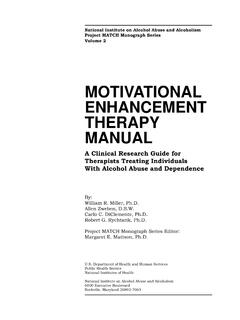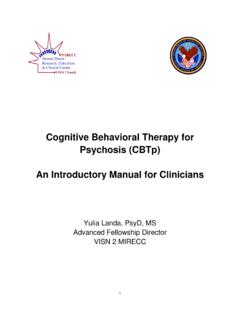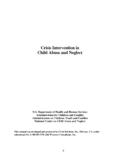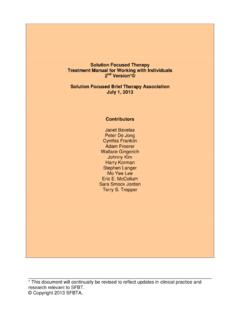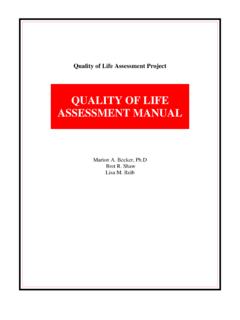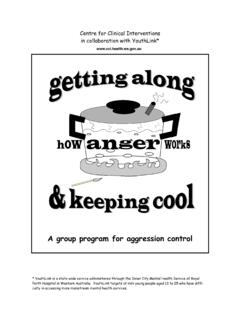Transcription of MINDFULNESS AND ACCEPTANCE-BASED GROUP THERAPY …
1 MINDFULNESS AND ACCEPTANCE-BASED GROUP THERAPY FOR SOCIAL ANXIETY DISORDER: A treatment manual Second Edition* Jan E. Fleming, MD, FRCPC Nancy L. Kocovski, PhD Clinical Associate Associate Professor The MINDFULNESS Clinic Department of Psychology Toronto, ON, Canada Wilfrid Laurier University *The first edition (2009) is available at and at June, 2014 1 2 Introduction Background MINDFULNESS and ACCEPTANCE-BASED GROUP THERAPY (MAGT) for Social Anxiety Disorder (SAD) is based on Acceptance and Commitment THERAPY (ACT.)
2 Hayes et al 1999), with additional MINDFULNESS components drawn from MINDFULNESS -Based Cognitive THERAPY (MBCT: Segal et al 2002), which is based in part on MINDFULNESS -Based Stress Reduction (MBSR: Kabat-Zinn 1990). Pilot work found that MAGT was feasible and acceptable to SAD patients and provided initial support for the effectiveness of the approach (Kocovski, Fleming & Rector, 2009). To further evaluate its effectiveness, we compared MAGT to cognitive behavioral GROUP THERAPY (CBGT: Heimberg & Becker) and a wait list control GROUP in a randomized controlled trial. MAGT and CBGT were both found to be significantly more effective than the control GROUP , but not significantly different from one another (Kocovski, Fleming, Hawley, Huta & Antony, 2013).
3 The first edition of our treatment manual was used in that trial (Fleming and Kocovski, 2009) and is available at , and at Given these promising findings for MAGT and additional research support for MINDFULNESS and ACCEPTANCE-BASED approaches for SAD (see the Evidence section of for details) we wrote The MINDFULNESS and Acceptance Workbook for Social Anxiety and Shyness (Fleming and Kocovski, 2013) in order to make the approach available to a broader audience. The workbook can be used on its own or as an adjunct to individual or GROUP THERAPY , as outlined in the second edition of the treatment manual . Second Edition of MINDFULNESS and ACCEPTANCE-BASED GROUP THERAPY for Social Anxiety Disorder: A treatment manual The second edition of the manual covers the same ACT concepts as the first edition.
4 It differs from the first edition as follows: It is written to be used in conjunction with The MINDFULNESS and Acceptance Workbook for Social Anxiety and Shyness. It presents the MINDFULNESS and acceptance approach in a more user-friendly way, which can be summarized as teaching GROUP participants how to shift from Safety Mode to Vital-Action Mode (described in detail in the manual ). The number of sessions has been shortened from 12 to 10; however, the manual can be modified to accommodate GROUP programs with fewer or more than 10 sessions. Updates and additional materials will be available on our website, , and our facebook page, Important Note: It is assumed that the therapist using this manual is familiar with the assessment and treatment of social anxiety.
5 Second, it is assumed that the therapist also has basic training in Acceptance and Commitment THERAPY . If you are interested in further training, we 3 recommend the official website of the Association for Contextual Behavioral Science (ABCS; ) for information about training opportunities. Access to some parts of the website requires membership. Membership to ABCS is values-based; in other words, you pay what you think it is worth and what you can afford. TABLE OF CONTENTS PA RT I : Therapist manual ..4 treatment Session 1: Safety Session 2: Session 3: Values and Session 4: Developing a Different Relationship to Thoughts: Session 5: Willingness Switch and Being With Your Session 6: Taking VITAL Session 7: Taking VITAL Action (continued) and Goal Session 8: Taking VITAL Action (continued).
6 111 Session 9: Taking VITAL Action (continued)..122 Session 10: Wrapping Up and Stepping PART II: Participant Part I: Therapist manual 4 treatment OVERVIEW The GROUP meets for 2 hours, once a week for 10 weeks. There are typically 8-12 members per GROUP and two therapists. Each session is roughly divided into four parts: MINDFULNESS Exercise: 15 minutes followed by 5 to 10 minutes of discussion (see summary below) Review of Homework: 15 to 30 minutes Session Theme: Introduction of ACT concepts using metaphors and experiential exercises (sessions 1-5) and ACT-consistent exposure, called Taking VITAL Action (sessions 6-10) (55-85 minutes) Homework Assignment: for the upcoming week (5 10 minutes) Summary of MINDFULNESS Exercises Session 1: Mindful Eating Session 2: Observing Mountain Session 3: Body Scan Session 4: MINDFULNESS of breath, sound and thoughts Session 5.
7 Mindful Stretching Session 6: Mindful Seeing, Acceptance of Feelings and Thoughts, Guest House poem Session 7: Imagining VITAL Action Session 8: Cultivating Self-Compassion Session 9: Loving-kindness Session 10: Imagining VITAL Action Note: The following materials are meant to be used as guidelines. Sample transcripts of MINDFULNESS and ACT exercises are meant to be tailored for individual groups. 5 SESSION 1 Safety Mode 6 Session 1 SUMMARY This is the only session that does not begin with a MINDFULNESS exercise or include homework review. OPENING REMARKS: Welcoming remarks and Housekeeping items are tailored for a spec ific GROUP and therapist(s) Session structure - Sessions will generally have 4 parts: 1.
8 MINDFULNESS exercise, 2. homework review, 3. New concept/ GROUP exercises, and 4. setting of homework INTRODUCTIONS: Instruct GROUP members to pair up and introduce themselves to each other ( Say something about what brings you here and what you hope to get out of the GROUP ) for several minutes (you can ring the bell after a couple of minutes and ask people to switch if one member of the pair/trio has not yet spoken) Each GROUP member then introduces his/her partner to the rest of the GROUP . Note: If there is an uneven number of participants, assign one GROUP of 3 and be sure to identify which GROUP members will introduce each other ( Mary, you ll introduce Tom, Tom will introduce Joe, and Joe will introduce Mary) SESSION THEME: Introduction to Safety Mode : see below for details therapist prep-MAWSAS, Chapter 2 MINDFULNESS EXERCISE: Mindful Eating See Exercise Mindful Eating therapist prep- MAWSAS, pgs 51-55 HOMEWORK: See Session 1: Homework for details 7 8 SESSION THEME: INTRODUCTION TO SAFETY MODE It is helpful to use a whiteboard when introducing Safety Mode.
9 Sample S cript: Now we re going to walk you through an approach to understanding how social anxiety keeps you from getting the most out of your life. The crux of the problem is something we c all safety mode, a w ay of be ing in social s ituations that can put up barri ers to what is really important to you in your life. We re going to introduce you to safety mode by using a specific example. So eve ryone imagine now that you are at a party where there is s omeone you would really like to meet. It could be a c o- worke r, a n eighbour, someone you re a ttracted to or someone you really respect. Does everyone h ave s omeone in mind?
10 Now imagine that you notice that person standing alone by the food table, looking lost, and you decide to go over a nd make small talk with them. If you wouldn t be a nxious in this situation think of a r ecent sit uation where you felt anxious and use that as we pr oceed. Goal in S af ety Mode: Safety mode is about staying out of harm s way, about pr otecting your self from social danger. Soc ial danger is what you are afraid might happen in a social situation. So what might be dangerous about this party? Wha t are you afraid might happen? Wha t are your w orst fears? (gr oup members shar e fears such as embarrass self, appear anxious, be judged, etc).


